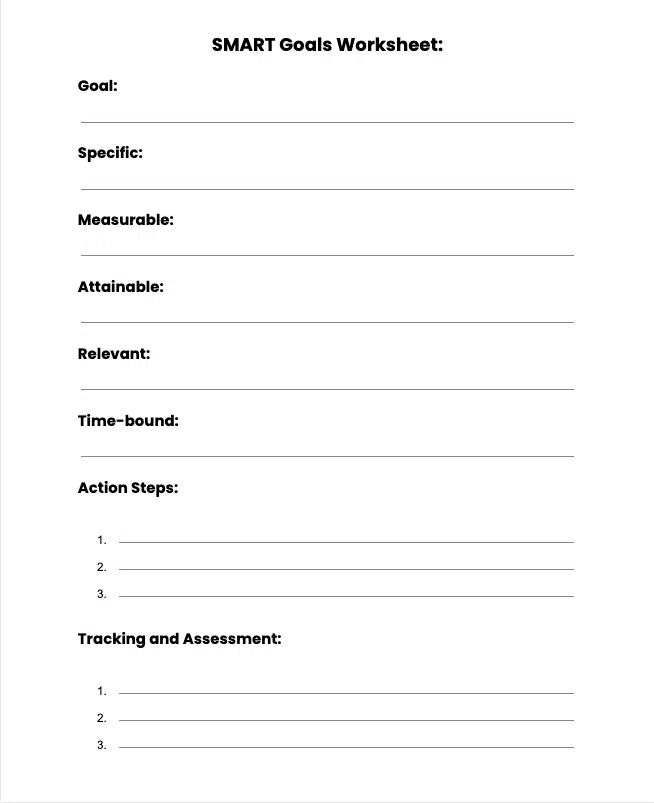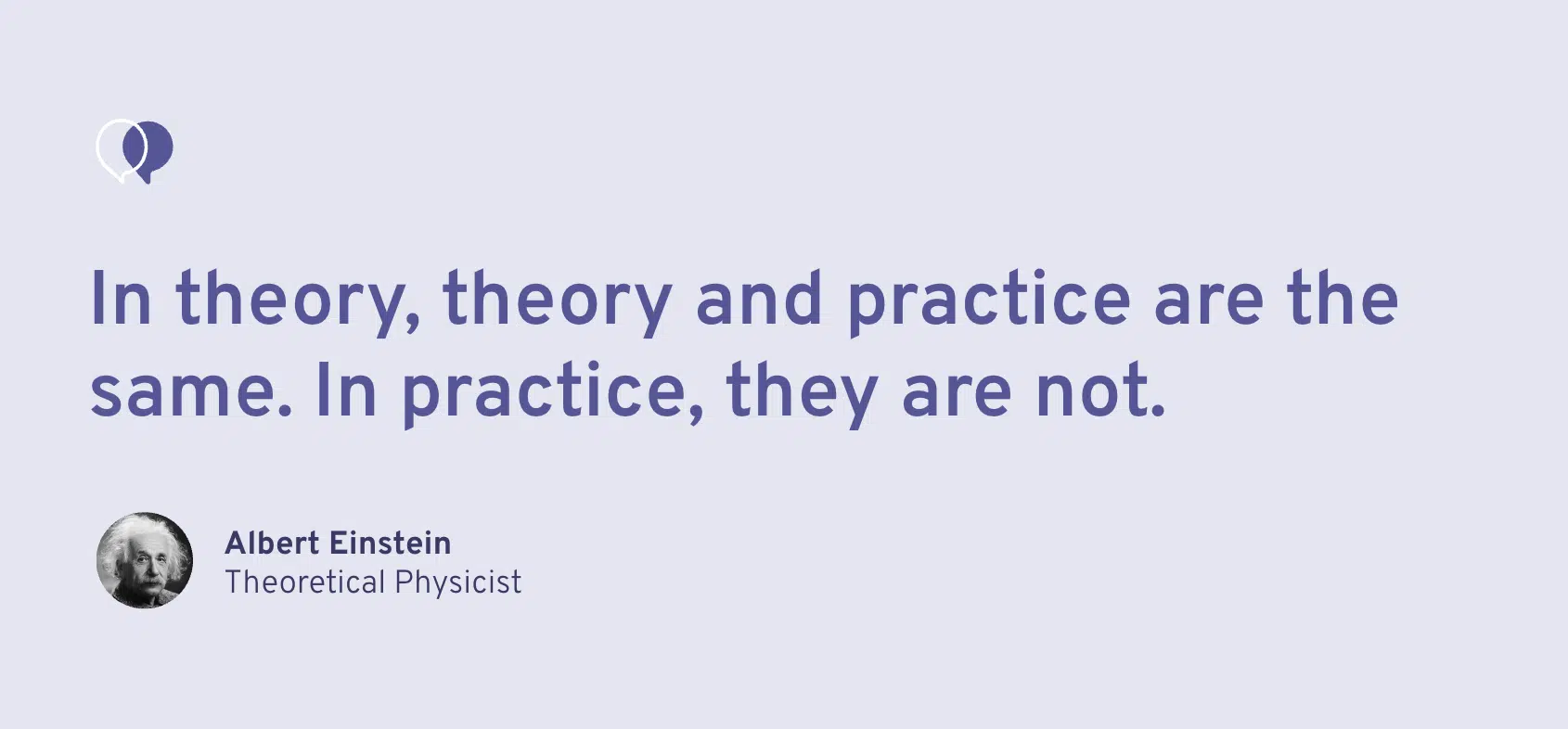Goal setting gives people something to drive toward while providing purpose and clarity. And yet, goals rarely possess the necessary potency when they’re dictated by someone else. Managers must balance company vision with team members’ own development desires, all amid upheaval and debate regarding where, when, and how we should work to be most effective. Building a framework for your team to understand how to set goals is critical to tracking and measuring overall performance. Since you’re likely required to do some goal setting as part of your managerial duties, ensure you get the most out of it. This article will discuss the tools and steps to use goal setting for managers as an opportunity to inspire, develop buy-in, and unify your team.
A Guide to Goal Setting for Managers
Many business practices are a balance between science and art. Goal setting is no different. As a manager, you must understand how to succeed on paper and how far you can push your team to achieve their goals. Top-performing companies set the clearest goals, from the C- suite to each manager and direct report.
As a manager, it’s essential to know what is expected from executive leadership and how to communicate what your team will be responsible for throughout the year. This will enable group synergy to strive for a shared outcome while also providing a focus on how each individual contributes.
The Importance of Goal Setting in the Workplace
To establish a path to success, employees must know how their skills, experience, and personalities combine to help the company achieve its intended outcome. More than ever, the workforce now reflects individuals who are seeking greater value and purpose at work.
Managers and L&D leaders who can align company values with goals establish a sense of purpose that is carried out and reinforced daily. Goal setting allows each manager to initiate checkpoints to reflect the company’s ambitions and show progress indicators for your team and employees. These milestones are helpful in performance reviews and follow-ups as the year progresses to identify accomplishments and growth opportunities.
There are a lot of choices when it comes to goal setting and defining key terms for your team to follow. If you are a new manager or have years of experience, chances are you’ve tried or adopted several goal-setting methods.
No matter what formula or framework you choose, there are some critical factors in goal setting to keep in mind. First, try your best to stay consistent with each employee when defining and reinforcing how you communicate, measure, and evaluate performance for each goal during goal setting. To get started with goal setting, break down the components that make up a goal, and be sure everyone is on the same page.
The Right Mindset When Setting Goals
The first step in goal setting is to get out of your comfort zone. Don’t set the bar too low, where you are almost guaranteed to succeed every time. Instead, break the status quo and identify ways to move the business and your team forward. Be a visionary, and don’t be afraid to make mistakes; they are going to come along the way.
At the same time, be realistic. Don’t be like the professor who always had to grade tests on the curve because everyone would be doomed to flop. Managers need to inspire and spark creativity, unity, and perseverance, but high standards are all relative. Don’t get too stressed with being demanding or trying to impress your boss.
Your team will appreciate encouraging hard work and challenging objectives, but each goal in goal setting should be fathomable and attainable. And it would be best if you showed it to prove to your team it can be done. Vision without action is not going to work.
“Vision without action is merely a dream. Action without vision just passes the time. Vision with action can change the world.” – Filmmaker, Joel Arthur Barker
Alright, so you’ve put in the work and are in the right mindset. First, let’s define what a goal should be. There is a lot of vocabulary thrown around that can get confusing quickly for your staff. OKRs, KPIs, Goals, Objectives, Rocks…you name it, someone has probably used these terms interchangeably or inconsistently. So, the basics, let’s set some rules in place for a uniform understanding.
What are Goals?
Goals are attainable outcomes that are typically measured long-term and in a broad fashion. These are the big moments or metrics you can point to that create exceptional value and performance evaluation for your business. A helpful thought when considering what goals should be is to ask three questions.
- Will this ______ start something?
- Will this ______ improve something?
- Will this ______ reinvent something?
Objectives and Key Results (OKRs)
Much ink and many pixels have been spent describing OKRs. Created by Andy Grove at Intel in the 1970s and popularized by his colleague John Doerr, this framework remains used by large and small organizations around the globe to set and meet goals.
Objectives
The OKR process begins by defining objectives. Objectives answer the question, “Where do we want to go?” Typically higher-level and inspirational, these outline what the organization or team wants to accomplish. For example, a finance department objective might be to “Drive efficiency and eliminate wasted time and effort.”
Key Results
Next comes drilling down into the key results that support each objective. Key results measure progress toward a goal. They answer the question, “How do I know I am progressing toward the objective?”
Since measurable progress is the goal, key results must be quantitative, measurable, and directly connected to the objective it is measuring. Going back again to the finance department example, a key result tied to the efficiency objective could be “Reduce quarter-end close duration from five days to three.”
Initiatives
After zeroing in on what we want to accomplish and how we will measure progress, it is time to determine the actions needed to deliver that progress. These tasks drive progress and answer the question, “what will I do to get there?”
In the finance department example, an initiative related to the key result of closing the books faster each quarter may be “Automate the reconciliation of cash every month.”
Why OKRs Work
The OKR framework has persisted for so long because of its effectiveness in bringing together a top-down strategy and bottom-up action. By linking the two together, companies take the focus off specific tasks and instead focus on the value those completed tasks deliver to the overall organization.
OKRs typically get implemented in a cascade. First, company-wide objectives get several key results associated with each objective. Each key result gets assigned to a function or department and becomes the objective for that group, and new key results are defined to support the objective. This flow continues from the top down until every team has goals, key results, and initiatives.
What are Objectives?
Objectives define the actions that take place to achieve goals. Most of the time these are more short-term indicators and must be measurable. Objectives help you assess and understand if you will achieve your goals. The goals themselves help describe the direction you want to go in, and objectives explain how to follow the direction.
Establishing an OKR Framework
Andy Grove, whom some consider “the father of management science,” created the OKR methodology while working for Intel in the mid-1900s. Today, many Fortune 500 companies and industry leaders have adopted this philosophy. Google, Apple, and Netflix are adopters of this management style, to name a few. This thinking was revolutionary for the time and has transformed how businesses run and define success today, not just by title or rank but by performance and achievement from defined measurement.
The OKR framework is broken down into a few simple components.
- Objectives – Inspired actions for the direction you want to go
- Key Results – Steps that measure progress toward an objective
- Initiatives – Tasks to drive progress
Combining these elements gives a comprehensive plan and standard guide to develop, follow through, and evaluate each goal set for your organization. The OKR methodology is not meant to be siloed. Instead, it helps give your entire company and each department a transparent view of what your team is focused on and how you work to achieve the overall goals or the company vision.
Many times there are requests between departments that can shake up bandwidth and distract from the main goals of each manager or team member. The OKR framework provides an objective way to “say no” or prioritize tasks and requests to keep everyone accountable and move toward shared outcomes.
Training Your Team to Set Goals
Goals should have a standard blueprint within your organization so everyone understands how to structure and incorporate them within each team. Time is essential to train your team when it comes to goal setting.
As we mentioned, goals are broad and usually span a lot of time. So when you consider your company vision, this should be your source of truth for training within 5-10 years. At that point, maybe you take a deeper look and see if it still holds and is serving the needs of your customers and employees.
Company objectives following your company vision and long-term goals should be considered in a year or shorter. From here, you can divide each objective by department and then further into key initiatives for each team and individual. Managers should assign the time to properly train their direct reports on creating key results and understanding the flow of performance accountability.
Key Results Should be SMART
Key results are milestones that, if achieved will advance the objective in a helpful manner. Try your best to set 3-5 critical results for each objective. Here is a short example to explain the concept.
| OKR – Delight Your Customers
Key Result 1: Net Promoter Score of 42 or better Key Result 2: Order Rating of 4.6 / 5.0 or better Key Result 3: 75% of customers prefer our product to our competitor in a taste test |
SMART = Specific, Measurable, Attainable, Relevant, Time-Based
Using the SMART formula gives parameters to evaluate each key result in an organized and uniform way. It helps answer the what, when, and how questions that each department or team leader might throw your way. After all, the business must be run efficiently, effectively, and in a manner that displays a sense of purpose and unified direction.
Let’s break down key results a little further so you can understand what each SMART element identifies.
Specific
While objectives can be higher-level or aspirational, goals and key results must be concrete. For a marketing department, a key result of “Increase email response rate by 20%” is far more specific and, therefore better than “Improve customer engagement.”Make your key results specific and narrow for more effective planning. e.g., “Get 50% of our customers to engage with the new ordering feature.”
Measurable
A goal must be measured. Otherwise, you risk becoming mired in debates about whether or not you hit it. For our outbound marketing team, that looks like exchanging the weaker goal of “sending more outbound emails” for a stronger goal of “Increasing email campaigns by 15%.” Choose an indicator that can be quantified or qualified, and leave out gray areas. Measurable key results can either be numerical (x %) or binary (complete or incomplete). e.g., “Reach a click-through rate of 45% for email newsletters.”
Attainable
A company might have a lofty vision of getting their software into every organization in a specific sector. But this isn’t a helpful goal since it’s hard to know when it will be met, and it is not likely achievable in the given timeframe. An attainable goal is “increase conversion rate by 7%” rather than “Turn every prospect into a sale.” Inspire change and disrupt the status quo, but make sure this key result is reasonable and within the scope of your efforts and capacity. e.g., “Reduce our customer response time average from 4 hours to 2 hours.”
Relevant
Your goals comprise a large part of how your performance and effectiveness are evaluated, so ensure all your efforts stay aligned with the organization. Your passion for improving documentation lacks a connection to company benefits or strategy, taking time away from things that actually contribute to organizational success.
Choose key results that are sufficient for achieving the objective. e.g., “Pass security audit” for the objective “Secure our IT infrastructure.”
Time-Based
Goals are a final destination, not an itinerary. It is good to know where you are going, but you also need to know when you will arrive. Establishing time-based goals forces you to make valuable tradeoffs because you only have so many weeks until the quarter or year ends. Time-based goals ensure everyone stays on the same page about the amount of time available to meet the goal. Set an end date for your key result that is ambitious and motivates action. e.g., “…by the end of Q3.”
Smart Goals Worksheet
6 Steps for Goal Setting: A manager’s guide to set better goals
Armed with an understanding of the OKR process and wise to SMART goals, you are now ready to tackle goal setting with your team.
1. Start with the proper context for goal setting.
Your team doesn’t exist in a vacuum, and your goals shouldn’t either. Stay well-grounded in the organization’s OKRs and overall ethos. For example, goals around offering a product to consumers conflict with a company laser-focused on the B2B market.
Unless you’re a small company, you probably have company-wide objectives, as well as group- and department-level objectives and key results. Make sure you understand the lineage of the objectives handed down to you. “Grow subscriber base by 15% in Q2” is a great goal, but you also must know which specific types of subscribers the company prioritized.
Marrying the top-down vision with bottom-up action ensures everyone moves in the same direction, reducing potential conflict around priorities.
2. Use disruption to inspire.
Frequently a corporate requirement, the goal setting process also creates a significant opportunity to unite your team around joint efforts. To inspire this kind of commitment, however, you need compelling goals. Focusing on disruption generates objectives and goals that feel more exciting.
There are typically three ways to disrupt the status quo–start something new, improve something, or reinvent something. First, energize your team by emphasizing the change or progress of the goal and connecting it to something more significant.
Some “blah goals” and their inspirational makeovers
Check out the below “blah” goals and their more inspirational makeovers.
Instead of: Increasing communication with senior management on the impact of marketing initiatives.
Try: Launch a new interactive dashboard that lets users drill into the outcome of specific marketing initiatives.
Instead of: Develop a report on prospects at each stage in the sales funnel.
Try: Reimagine and automate the sales funnel reporting process.
Instead of: Reduce the use of single-use products across the corporate footprint.
Try: Increase environmental sustainability by migrating to multi-use alternatives.
3. Define SMART key results.
We outlined the above key results and how to make them SMART–specific, measurable, attainable, relevant, and time-based. Key results merit their required time investment. Avoid falling down a rabbit hole of complexity and calculations when contemplating metrics to indicate progress.
Thanks to their clarity and simplicity, you can describe great key results to a colleague in the elevator. An objective outsider should be able to look at your goals and key results and determine the likelihood of hitting your objective by year-end.
4. Plan initiatives.
After nailing down your key results, spend some time thinking through the necessary actions to get there. Initiatives capture bundles of work, likely containing many tasks carried out by multiple people.
The goal is not to create a full-fledged project plan but to determine, for example, what changes must happen to the email creation process to increase click-throughs. Then, after outlining initiatives for each key report, take a step back.
Do you need to request more or different resources to accomplish the key result? Are you creating an idealized solution or biting off more than you can realistically chew? Your initiatives represent your commitment to how you will spend at least some of your time, so remain pragmatic about what you can achieve.
5. Socialize and refine.
While working with your team to build new objectives or rework handed-down objectives into something more engaging, you will understand what the team cares about. Hopefully, people will feel energized and excited to get to work. To set yourself up for maximum success, work with key stakeholders to ensure sales goals mesh with the marketing goals, and so on.
If the finance team’s goal of integrating the general ledger system with the e-commerce system overlaps with the IT team’s plan to migrate it to the cloud, negotiate a bit. Avoiding unexpected conflicts and outflank them by socializing and refining them before you’re halfway done and at odds with a key partner.
6. Set checkpoints to gauge progress against critical results.
Like all strategy initiatives and documents, revisit OKRs regularly to remain relevant. Determine a cadence for evaluating current progress against key results. Checking in on progress against key results on at least a quarterly basis should reduce the odds of any year-end surprises.
Your goals also deserve a fresh look regularly. When you selected these goals, you, by default, also chose not to pursue other goals. New ideas don’t stop just because you set goals; new ideas, needs, and demands will emerge throughout the year.
Your OKRs provide a good lens through which to consider new requests and assess their alignment with your goals. This brings reality into the conversation. If your team gets asked to take on a significant surprise initiative, sit with management and discuss which OKRs to pause or abandon to make room for this new surprise initiative. This also forces management to acknowledge the tradeoffs being made.
Get the Most Out of Your Goal Setting Efforts
With a time-tested framework and effective strategy for setting goals in your toolbox, you’re now ready to plunge in. Use the goal setting process to collaborate with your team to create shared objectives and key results, increasing the buy-in and engagement needed company-wide for success.
Goal setting with your team is essential to show how you are aligned with your company vision and managing each direct report. This takes practice, and if you are trying it for the first time, don’t worry – it will take time and patience to get it right with your team, but it is well worth the effort.
Sometimes the most challenging part of goal setting is finding a place to easily define and track your progress with your leadership, department managers, and each employee. Our team at Hone is devoted to providing the tools and coaching necessary to ensure each manager is confident in delivering goal setting training and best practices.
We have expert coaches that can help educate your team and management to ensure goal setting training success at each business level or unit. Please let us know if we can help or join an upcoming webinar to see what we are all about!














